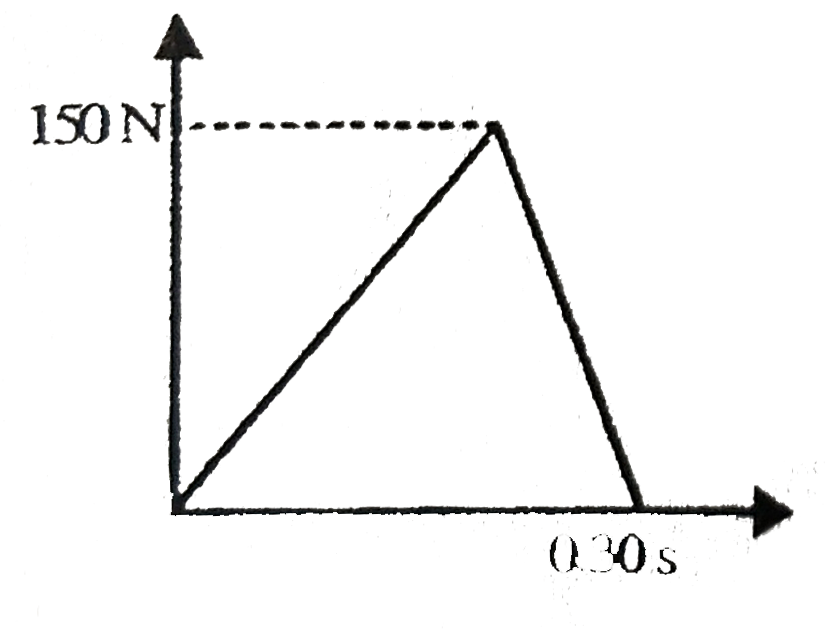Two bodeis A and B of masses 5.00 kg and 10.0 kg respectively moving in opposite directions with velocities 4.00 m/s and 0.50 m/s respectively make head-on collision in free space. The force of their mutual interaction varies according to the given graph. Select incorrect statement.

Period of deformation is 0.20 s.
Coefficient of restitution is 0.4.
Body A will move with velocity 0.5 m/s in the original direction.
Body B will move with velocity 1.75 m/s in the opposite direction.
The correct Answer is:C
Common velocity at maximum deformation
Change in momentum of 5 kg ball in deformation period
In this period impulse
Therefore period of deformation and period of recovery
Coefficient of restitution
Final velocity of body A
Final velocity of body B
Topper's Solved these Questions
- BOOK - ALLENCHAPTER - TEST PAPERSEXERCISE - Part-1 Physics15videos
TEST PAPERS
- BOOK - ALLENCHAPTER - TEST PAPERSEXERCISE - part-2 physics63videos
TEST PAPERS
- BOOK - ALLENCHAPTER - TEST PAPERSEXERCISE - PAPER 260videos
TEST PAPERS
- BOOK - ALLENCHAPTER - TEST PAPER 4EXERCISE - PHYSICS45videos
TEST PAPER 4
- BOOK - ALLENCHAPTER - UNIT & DIMENSIONS, BASIC MATHS AND VECTOR EXERCISE - Exercise (J-A)7videos
UNIT & DIMENSIONS, BASIC MATHS AND VECTOR
Similar Questions
Two bodies of masses 2 kg and 4 kg are moving with velocities 2 m/s and 10 m/s respectively along same direction. Then the velocity of their centre of mass will be
View SolutionTwo object A and B are moving along the same straight line in opposite directions with velocities 10m/s and 5m/s respectively. They collide during which they stick to each other. If mass of A is 1.5kg and mass of B is 1kg, what is the velocity of the combinations?
View Solution
Knowledge Check
- Question 1 - Select One
The solid rubber balls A and B having masses 200 and 400 gm respectively are moving in opposite directions with velocity of A equal to 0.3 m / s . After collision the two balls come to rest, then the velocity of B is
A0.15 m/secB1.5 m/secC–0.15msecDNone of the above - Question 2 - Select One
The solid rubber balls A and B having masses 200 and 400 gm respectively are moving in opposite directions with velocity of A equal to 0.3 m / s . After collision the two balls come to rest, then the velocity of B is
A0.15 m/secB1.5 m/secC−0.15msecDnone of the above - Question 3 - Select One
Two bodies of masses 0.1 kg and 0.4 kg move towards each other with the velocities 1 m/s and 0.1 m/s respectively, After collision they stick together. In 10 sec the combined mass travels
A120 mB0.12 mC12 mD1.2 m
Two particles A and B of equal size but of masses m kg and 2 m kg are moving directly towards each other with speeds 21 m/s and 4 m/s respectively. After collision, A moves with a speed of 1 m/s in the original direction. Then:
View SolutionTwo particles of mass 1 kg and 0.5 kg are moving in the same direction with speed of 2m/s and 6 m/s respectively on a smooth horizontal surface. The speed of centre of mass of the system is
View SolutionTwo particles A and B of masses 10 kg and 38 kg, respectively, are moving along the same straight line with velocities 15 m/s and 3 m/s, respectively, in the same direction. After elastic collision, the velocities of A and B are vAand vB, respectively, in the direction of initial motion. Then
 View Solution
View SolutionTwo particles of masses 2kg and 3kg are projected horizontally in opposite directions from the top of a tower of height 39.2m with velocities 5m/s and 10m/s respectively. The horizontal range of the centre of mass of two particles is
View SolutionTwo bodies having same mass 40 kg are moving in opposite direction. One with a velocity of 10 m/s and the other will 7m/s. if they collide nd move as one body, the velocity of the combination is
View Solution

